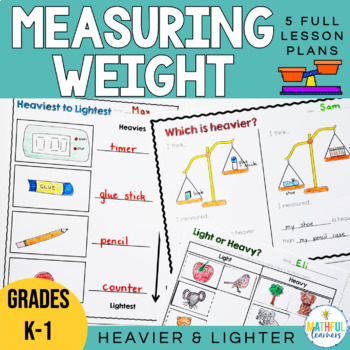Weight & Mass Measurement Comparing Objects Heavier Lighter K-1
- PDF
What educators are saying
Description
Teach the measurement concepts of heavier and lighter to your kindergarten and Grade 1 students with this FULL week of lesson plans focusing on measuring and comparing weight and mass. Learners will love to compare measurements of familiar objects, explore heavy and lighter with flashcards, complete cut and paste weight worksheets and engage with these fun measurement activities.
Great care and thought has been put into each lesson so learning is gradual throughout the week and meets appropriate learning outcomes for kindergarten and Grade 1 students. So this pack of weight & mass measurement activities for kindergarten and grade 1 is your one stop shop with everything included for teaching measurement of weight & mass!
What’s included in these Weight & Mass Measurement Activities for Kindergarten & Grade 1?
- Full instructions for each measurement activity
- Warm up discussion/activities, a whole class/small group activity and a reflection prompt
- Flashcards with appropriate terminology
- All resources, just add objects from around the classroom and balance scales
Please note: 6-8 sets of balance scales would be helpful to complete these activities in small groups. Alternatively, activities can be completed as a whole class.
Measurement activities included:
- Day 1 - Investigating objects heavier and lighter than themselves
- Day 2 - Comparing two objects
- Day 3 - Comparing objects in the classroom and using balance scales
- Day 4 - Ordering items from heaviest to lightest
- Day 5 - Does big mean heavy?
Ways to use these Heavier & Lighter worksheets in the classroom:
- As math measurement centers in small groups
- During whole class learning experiences
These measurement activities are linked to the curriculum/standards:
Australian Curriculum
- Foundation ACMMG006 - Use direct and indirect comparisons to decide which is longer, heavier or holds more, and explain reasoning in everyday language
- Grade 1 ACMMG019 - Measure and compare the lengths and capacities of pairs of objects using uniform informal units
US Common Core Standards
- CCSS Math K.MDA.1
- CCSS Math K.MDA.2
Please see images and preview for more detail.
If these heavier & lighter worksheets are the perfect fit for your classroom, you will also love:
⭐ One to One Correspondence Number Sense Activities
Get free TpT credits for future purchases!
If you like this resource, then I’d love to hear from you! Select “My Purchases”, choose ratings and leave feedback and you will receive free credits to be used on your next TpT purchase.
Want 50% off all new releases for the first 24 hours?
Follow Me so you are the first to know!
Thank you!
Let’s Connect
Follow me on Instagram, Facebook and visit my website Mathful Learners for more great tips to use in your classroom.
_____________________________________________
COPYRIGHT ©Alison Hislop of Mathful Learners
Permission for personal use in a single classroom. Please purchase additional licenses for use in multiple classrooms.





